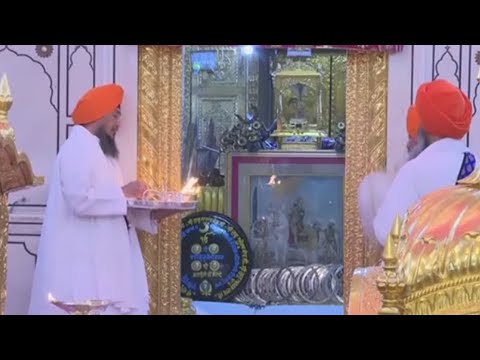This was the first video put together and uploaded on the Traditional Dharmic Truth Seeker YouTube channel on Oct 20, 2020.
The long video description underneath it has generally remained the same (more or less) ever since the video was first uploaded back in 2020. The description has been tweaked a little bit since and it seems that the video description has been copied and pasted on social media sites by viewers. The original source of information was this YouTube video and the latest description is pasted here below.
Description:
This is the traditional Arti – Arata ceremony being done at Hazur Sahib in the melodious voice of Hazuri Ragi Bhai Veer Singh Ji and their Jatha.
I made this video project by combing multiple streams and adding images for those who wish to educate themselves on this old Khalsa tradition. Sadly, there is some hostility and misinformation spread by malicious entities on this time-honoured practice. Aarti-Arta is a very important Khalsa ritual which is a part of the puratan (old) Akali Maryada established by Guru Gobind Singh Ji. Puratan (old) texts, and especially Dasam Granth, describe this same Aarti as a form of giving respect to higher-ups (such as Kings, Gurus, Deities, etc.) and the Khalsa used to offer this Aarti to Guru Sahib in almost every Gurdwara in North India. After the fall of Maharaja Ranjit Singh’s empire and a heavy loss faced by the Sikh population in Punjab, this Aarti was stopped in the process of reforming Sikhi to assert to the British and the reformist Hindu movements, that Sikhism had nothing in common with “Hindu” beliefs and practices. A detail overlooked was that all dharmic religions share many concepts due to their common origins on the Indian subcontinent. Due to the polarization created during the colonial-inspired reforms, Aarti and many Khalsa traditions were stopped or suppressed by the British-educated reformists, merely due to their resemblance to similar Hindu practices. Many people today carry a misconception that Guru Nanak Patshah criticized the Aarti with Deeve at the Jaganath Puri temple. Exaggerations, perversions and misrepresentations have distorted such Sakhis in the recent past. People seem to focus on the Deeve (Lamps), yet the bani talks about Chaur Sahib too (Chawar Sahib). In reality, Guru Nanak Ji composed a devotional transcendent Aarti of Nirankaar (the formless almighty lord) and gave a new dimension/based it off of the Sargun Aarti performed by humans. The Sikh Aarti is all-inclusive in which the physical worship component is directed towards Guru Sahib. Even popular collections of Sakhis such as Kalgidhar Chamatkar record multiple instances where Aarti of Guru Sahib was performed like this by the Sangat. Guru Sahib does not criticize the physical Aarti at all. Famous poet and intellectual Rabindranath Tagore even described the Aarti Shabad of Guru Nanak Ji as the universal anthem of unity. Guru Sahib united everyone and never divided. Yet we humans seem to find a way to resort to our divisive behaviors. The physical Aarti maintains the old Indian tradition of respect to higher-ups and directs that respect to Guru Sahib and the sacred Shasters. Prior to 1920, Aarti was done like this in all Takhts and major Gurdwaras, but the Singh Sabha movement banned the Dhoop (Incense) Deep (Lamps) Aarti, yet maintained the Chaur Sahib. Outside of Punjab, the Singh Sabha reforms were unpopular and irrelevant. Puratan Sampardas and the Hazuri Singhs refused to accept the short-sighted reforms and still maintain the full Aarti which includes the Shabad Kirtan for Waheguru and the Aarti ceremony for Guru Sahib and Shasters. Aarti is not a “Bipran Ki Reet”, as some people blindly label every traditional Sikh practice. If one looks at our old literature and manuscripts one will find that Bipran Ki Reet very specifically was directed to traditions such as ritually shaving the hairs and being bald, which no Khalsa ever does! Guru Gobind Singh Ji wanted Sikhs to not follow the Brahminical tradition of shaving the hairs during the birth, death, and initiation ceremonies, which was a practice encouraged in the Brahmin-led traditions back then. Aarti was NEVER once deemed to be a Bipran Ki Reet, but was instead seen as an act of devotional love, and many Mahapurush have maintained this practice. One can argue that Aarti is in fact a Kshatriya Ki Reet and the Khalsa is no doubt a “Kshatriya Panth” as envisioned in Sri Dasam Granth Sahib.
Today Aarti-Aarta is still practiced by all major Nihang Jathebandian, Takhat Hazur Sahib in Maharashtra and Takhat Patna Sahib in Bihar and many other Sikh/Nanak Naam Lewa Jathebandis/groups.
If Guru Sahib wanted this Aarti to be stopped, inspiring verses in Dasam Granth Sahib wouldn’t have elaborated on how it was done by the Devas and other heavenly deities, and Bhagat Sain Ji’s Shabad wouldn’t have been included in Guru Granth Sahib Ji, which states,
ਧੂਪ ਦੀਪ ਘ੍ਰਿਤ ਸਾਜਿ ਆਰਤੀ ॥
धूप दीप घ्रित साजि आरती ॥
With incense and ghee lamps, I offer my Aarti (ceremony of waving lamps).
ਵਾਰਨੇ ਜਾਉ ਕਮਲਾ ਪਤੀ ॥੧॥
वारने जाउ कमला पती ॥१॥
I am a sacrifice to the Lord of Kamala (Lakshmi) [The Sargun Roop of Waheguru]. ||1||
(ਗੁਰੂ ਗ੍ਰੰਥ ਸਾਹਿਬ : ਅੰਗ ੬੯੫)
Love all and respect all! Learn more about the amazing things in the world. Please like and subscribe for inspiring more content!
Waheguru Ji Ka Khalsa, Waheguru Ji Ki Fateh!
Copying and publishing of the information shared on PuratanM.com and Traditional Dharmic Truth Seeker without permission, proper citation, and/or appropriate credit given is a violation of copyright and an infringement of intellectual property.
